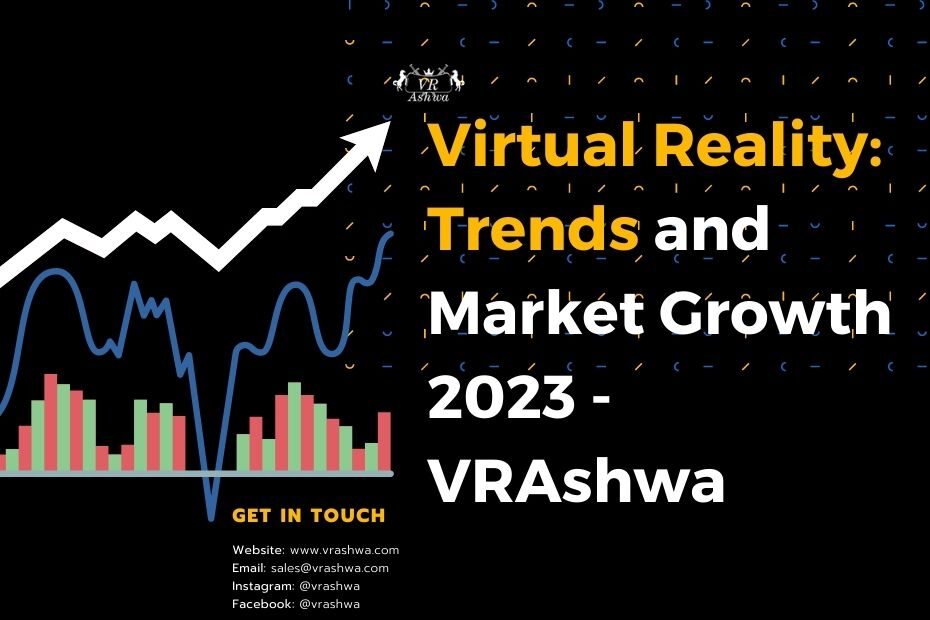Virtual reality (VR) has been making waves in recent years, and the latest statistics indicate that it’s set to become an even more critical part of our lives shortly. As a marketer, it’s essential to understand how VR is changing the digital marketing landscape and how it can create more engaging and immersive experiences for your audience.
In simple terms, VR is a computer-generated three-dimensional environment that can be experienced through special devices such as headsets, goggles, gloves, and more. The latest virtual reality statistics show that the global market size of augmented reality (AR) and VR is forecast to hit $296.9 billion in 2024, nearly ten times the $30.7 billion market size registered as recently as 2021.
What’s more, between 2021 and 2028, the compound annual growth rate of the market is expected to come in at 18 percent, with the oil and gas and manufacturing industries expected to be the primary driving forces of this growth. The popularity of VR is also on the rise, with nearly one in five US consumers having used VR in 2020—a three percentage point increase from 2019.
As the demand for AR and VR devices continues to increase, it’s precise that these technologies will play a significant role in shaping the future of digital marketing. In this blog, we’ll delve deeper into the latest virtual reality statistics and explore how marketers can harness the power of VR to create engaging and unforgettable experiences for their audience.
The Augmented Reality (AR) and Virtual Reality (VR) market is growing at an unprecedented rate, with a forecasted global market size of $296.9 billion in 2024. To put that into perspective, in 2021, the market size was just $30.7 billion. The forecast for 2023 is already a 91.2 percent year-over-year increase, which is set to more than double to $124.4 billion in 2023 before skyrocketing in 2024.
The AR and VR market growth can be attributed to the increasing popularity of these technologies and the investments made by tech companies such as Microsoft, Intel, and Sony. These companies are pouring large amounts of money into the development and advancement of VR, leading to the creation of more advanced and sophisticated devices.
One of the primary reasons for the AR and VR market growth is the wide range of applications that these technologies offer. For example, VR can simulate real-life scenarios in healthcare, education, and aviation. In addition, AR can be used to overlay digital information onto the real world, providing users with a unique and interactive experience.
The COVID-19 pandemic has also played a role in the growth of the AR and VR market, as people are increasingly turning to these technologies for entertainment, education, and communication. With the rise of remote work and online learning, AR and VR have become essential tools for many individuals and businesses.
Virtual reality (VR) is one of the most fascinating and rapidly evolving technologies in the digital world. Over the years, the VR market has grown tremendously and is expected to continue in the foreseeable future. According to Grand View Research, the VR market is expected to grow at a compound annual growth rate (CAGR) of 18 percent between 2021 and 2028.
This significant growth is driven by several factors, with two primary driving forces being the oil and gas and manufacturing industries. Companies in these sectors have identified the potential of VR and are investing heavily in its development and implementation. For instance, oil and gas companies leverage VR to train workers in hazardous environments, while manufacturing companies use it to improve efficiency and productivity.
However, it is not just the oil, gas, and manufacturing sectors leveraging VR. Other industries, such as fashion and retail, are also starting to realize the benefits of this technology. During the coronavirus pandemic, UK-based ecommerce company ASOS used VR to digitally fit its models with new designs, which helped the company boost its fashion sales.
Given the tremendous growth potential of VR, many technology companies such as Microsoft, Intel, and Sony are investing heavily in its development. This is not surprising, considering that the VR market is expected to grow at an average of 18 percent annually until 2028. The potential applications of VR are vast and limitless, and its impact on various industries will be significant.
The Increasing Demand for AR and VR Devices: A Look into the Future
The virtual and augmented reality industry has been experiencing significant growth over the years, which is expected to continue. As more companies invest in AR and VR technology, the demand for devices supporting these immersive experiences is rising.
According to IDC, the number of AR and VR devices shipped globally is expected to increase from 9.69 million in 2021 to 14.94 million in 2023. This represents a 54.2 percent increase in just one year. Of this number, VR devices will account for 91 percent of all devices shipped.
The forecast for the next few years is even more impressive. In 2023, the number of devices shipped is expected to reach 23.22 million, while 32.76 million will be shipped in 2024. By 2025, experts estimate 43.87 million devices will be shipped worldwide, representing a more than seven-fold increase from 2020.
This trend can be attributed to the growing number of AR and VR technology applications across various industries. For instance, companies in the fashion industry are using VR to create virtual fitting rooms, allowing customers to try on clothes virtually. Similarly, VR headsets provide players with an immersive gaming experience in the gaming industry.
Virtual Reality Facts: Popularity Increase
Virtual reality has come a long way since it was first introduced. What was once a technology that seemed only possible in science fiction movies is now becoming more mainstream. In fact, recent data suggests that virtual reality is increasing in popularity among consumers. Here are some interesting virtual reality facts that prove just that.
According to AR Insider, nearly one in five (19 percent) US consumers used VR in 2020. This is a three percentage point increase from 16 percent in 2019. This increase in usage demonstrates that more people are becoming interested in and curious about virtual reality technology. It’s no longer just a niche interest for gamers or tech enthusiasts but a technology slowly becoming more accessible to the general public.
Moreover, most users are happy with the experience. Of those who tried virtual reality, 55 percent reported being extremely or moderately satisfied with their experience. This indicates that virtual reality technology is improving quality and delivering on its promises to provide users with an immersive and engaging experience.
As virtual reality continues to become more popular, we’ll likely see more and more companies investing in this technology. This can only lead to more advancements and innovations in the field, ultimately benefiting consumers. Whether for entertainment, education, or business purposes, virtual reality can transform how we interact with technology and the world around us.
Virtual Reality Usage in the US: A Growing Trend
Virtual Reality (VR) is becoming increasingly popular in the United States. According to eMarketer’s latest virtual reality statistics, in 2020, 52.1 million people in the US will use VR at least once per month. This marks a significant increase of 20.9 percent from 2019’s 43.1 million users.
As VR technology continues to evolve and become more accessible, more and more US residents are expected to start using VR more frequently. The monthly VR users are predicted to increase to 57.4 million in 2021 and 60.8 million in 2023. If the predictions hold, this means that in the four years from 2018 to 2023, the number of people using VR every month will have increased by an impressive 75.7 percent.
The use of VR is not just limited to entertainment and gaming. Technology has been increasingly used in healthcare, education, real estate, and other industries in recent years. For example, VR is used in healthcare for mental health treatment, pain management, and surgical training. In education, VR is used for immersive learning experiences that take students to different locations and times. In real estate, VR is used to showcase properties to potential buyers.
The increasing usage of VR is a testament to the technology’s potential and its ability to create new and exciting experiences. As VR technology evolves, we expect to see even more innovative uses that further fuel its popularity.
Conclusion
In conclusion, virtual reality (VR) and augmented reality (AR) are rapidly growing markets offering exciting market opportunities for marketers. The global AR and VR market is forecast to hit $296.9 billion in 2024, almost ten times the market size of $30.7 billion registered in 2021. This growth is expected to continue with a compound annual growth rate of 18 percent from 2021 to 2028. The oil and gas and manufacturing industries are predicted to be the primary driving forces of this growth.
The demand for AR and VR devices is also rising, with an estimated 14.94 million devices expected to be shipped in 2023, a 54.2 percent increase from 2021. In the US alone, 52.1 million people are expected to use VR technology at least once per month in 2020. This marks a 20.9 percent increase from 2019’s 43.1 million, with projections of further increases to 57.4 million in 2021 and 60.8 million in 2023.
With the increasing popularity of VR technology, marketers have a unique opportunity to engage with consumers in new and exciting ways. The VR possibilities are endless, from virtual product demonstrations to immersive brand experiences. As more and more people adopt this technology, marketers who can effectively leverage VR will be at a distinct advantage.

